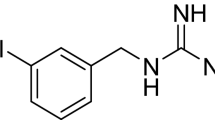Abstract
Purpose
Hospitalization in patients with systolic heart failure is associated with morbidity, mortality, and cost. Myocardial sympathetic innervation, imaged by 123I-meta-iodobenzylguanidine (123I-mIBG), has been associated with cardiac events in a recent multicenter study. The present analysis explored the relationship between 123I-mIBG imaging findings and hospitalization.
Methods
Source documents from the ADMIRE-HF trial were reviewed to identify hospitalization events in patients with systolic heart failure following cardiac neuronal imaging using 123I-mIBG. Time to hospitalization was analyzed with the Kaplan-Meier method and compared to the mIBG heart-to-mediastinum (H/M) ratio using multiple-failure Cox regression.
Results
During 1.4 years of median follow-up, 362 end-point hospitalizations occurred in 207 of 961 subjects, 79 % of whom had H/M ratio <1.6. Among subjects hospitalized for any cause, 88 % had H/M ratio <1.6 and subjects with H/M ratio <1.6 experienced hospitalization earlier than subjects with higher H/M ratios (log-rank p = 0.003). After adjusting for elevated brain natriuretic peptide (BNP) and time since heart failure diagnosis, a low mIBG H/M ratio was associated with cardiac-related hospitalization (HR 1.48, 95 % CI 1.05 – 2.0; p = 0.02).
Conclusion
The mIBG H/M ratio may risk-stratify patients with heart failure for cardiac-related hospitalization, especially when used in conjunction with BNP. Further studies are warranted to examine these relationships.



Similar content being viewed by others
References
Go AS, Mozaffarian D, Roger VL, Benjamin EJ, Berry JD, Borden WB, et al. Heart disease and stroke statistics – 2013 update: a report from the American Heart Association. Circulation. 2013;127:e6–245.
Jessup M, Abraham WT, Casey DE, Feldman AM, Francis GS, Graniats TG, et al. 2009 focused update: ACCF/AHA guidelines for the diagnosis and management of heart failure in adults. J Am Coll Cardiol. 2009;53:1343–82.
Allen LA, Gheorghiade M, Reid KJ, Dunlay SM, Chan PS, Hauptman PJ, et al. Identifying patients hospitalized with heart failure at risk for unfavorable future quality of life. Circ Cardiovasc Qual Outcomes. 2011;4:389–98.
Zaya M, Phan A, Schwarz ER. The dilemma, causes and approaches to avoid recurrent hospital readmissions for patients with chronic heart failure. Heart Fail Rev. 2012;17:345–53.
Cohn JN, Levine TB, Olivari MT, Garberg V, Lura D, Francis GS, et al. Plasma norepinephrine as a guide to prognosis in patients with chronic congestive heart failure. N Engl J Med. 1984;311:819–23.
Brunner-La Rocca HP, Esler MD, Jennings GL, Kaye DM. Effect of cardiac sympathetic nervous activity on mode of death in congestive heart failure. Eur Heart J. 2001;22:1136–43.
Sisson JC, Wieland DM. Radiolabeled meta-iodobenzylguanidine: pharmacology and clinical studies. Am J Physiol Imaging. 1986;1:96–103.
Yamashina S, Yamazaki J-I. Neuronal imaging using SPECT. Eur J Nucl Med Mol Imaging. 2007;34:939–50.
Verberne HJ, Brewster LM, Somsen GA, van Eck-Smit BL. Prognostic value of myocardial 123I-metaiodobenzylguanidine (MIBG) parameters in patients with heart failure: a systematic review. Eur Heart J. 2008;29:1147–59.
Jacobson AF, Senior R, Cerqueira MD, Wong ND, Thomas GS, Lopez VA, et al. Myocardial iodine-123 meta-iodobenzylguanidine imaging and cardiac events in heart failure. J Am Coll Cardiol. 2010;55:2212–21.
Jacobson AF, Lombard J, Banerjee G, Camici PG. 123I-mIBG scintigraphy to predict risk for adverse cardiac outcomes in heart failure patients: design of two prospective multicenter international trials. J Nucl Cardiol. 2009;16:113–21.
Chen J, Folks RD, Verdes L, Manatunga DN, Jacobson AF, Garcia EV. Quantitative I-123 mIBG SPECT in differentiating abnormal and normal mIBG myocardial uptake. J Nucl Cardiol. 2012;19:92–9.
Maisel AS, Krishnaswamy P, Nowak RM, McCord J, Hollander JE, Duc P, et al. Rapid measurement of B-type natriuretic peptide in the emergency diagnosis of heart failure. N Engl J Med. 2002;347:161–7.
Twisk JW, Smidt N, de Vente W. Applied analysis of recurrent events: a practical overview. J Epidemiol Community Health. 2005;59:706–10.
Cleves M. STATA Manual. StataCorp; 1999. Available from: http://www.stata.com/support/faqs/statistics/multiple-failure-time-data/.
Kyuma M, Nakata T, Hashimoto A, Nagao K, Sasao H, Takahashi T, et al. Incremental prognostic implications of brain natriuretic peptide, cardiac sympathetic nerve innervation, and noncardiac disorders in patients with heart failure. J Nucl Med. 2004;45:155–63.
Lautamäki R, Tipre D, Bengel FM. Cardiac sympathetic neuronal imaging using PET. Eur J Nucl Med Mol Imaging. 2007;34 Suppl 1:S74–85.
Nishioka SA, Martinelli Filho M, Brandão SC, Giorgi MC, Vieira ML, Costa R, et al. Cardiac sympathetic activity pre and post resynchronization therapy evaluated by 123I-MIBG myocardial scintigraphy. J Nucl Cardiol. 2007;14:852–9.
Agostini D, Belin A, Amar MH, Darlas Y, Hamon M, Grollier G, et al. Improvement of cardiac neuronal function after carvedilol treatment in dilated cardiomyopathy: a 123I-MIBG scintigraphic study. J Nucl Med. 2000;41:845–51.
Kasama S, Toyama T, Kumakura H, Takayama Y, Ichikawa S, Suzuki T, et al. Spironolactone improves cardiac sympathetic nerve activity and symptoms in patients with congestive heart failure. J Nucl Med. 2002;43:1279–85.
Suwa M, Otake Y, Moriguchi A, Ito T, Hirota Y, Kawamura K, et al. Iodine-123 metaiodobenzylguanidine myocardial scintigraphy for prediction of response to beta-blocker therapy in patients with dilated cardiomyopathy. Am Heart J. 1997;133:353–8.
Acknowledgments
The authors acknowledge Harry Lessig, MD, for assisting with the review of clinical source documents.
Disclosures
Dr. Jacobson is an employee of GE Healthcare, the study sponsor. Drs. Heller and Lundbye received grant support from GE Healthcare for this project.
Author information
Authors and Affiliations
Corresponding author
Additional information
Supported by an investigator-initiated research grant from GE Healthcare.
Rights and permissions
About this article
Cite this article
Parker, M.W., Sood, N., Ahlberg, A.W. et al. Relationship between quantitative cardiac neuronal imaging with 123I-meta-iodobenzylguanidine and hospitalization in patients with heart failure. Eur J Nucl Med Mol Imaging 41, 1666–1672 (2014). https://doi.org/10.1007/s00259-014-2819-2
Received:
Accepted:
Published:
Issue Date:
DOI: https://doi.org/10.1007/s00259-014-2819-2




